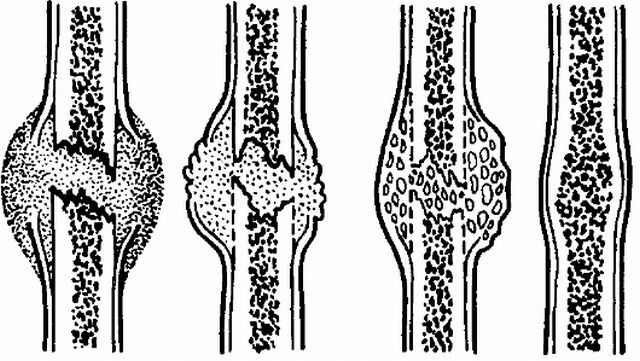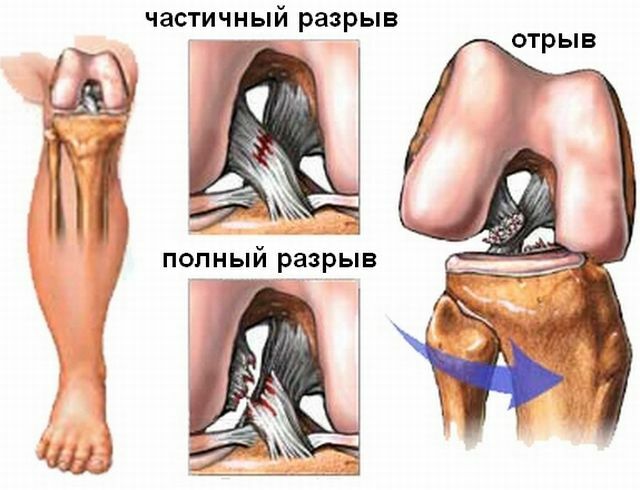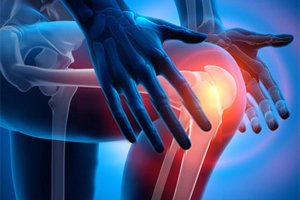 The knee is the largest joint in the human body in the formation of which the condyles of the hip, the upper articular surface of the tibia and the patella( knee cap) take part.
The knee is the largest joint in the human body in the formation of which the condyles of the hip, the upper articular surface of the tibia and the patella( knee cap) take part.
The knee joint consists of such joints: basic, femoral-tibial and femur-patellar.
Muscle structures and tendons that surround the knee joint come from the lower leg and thigh.
The patella is a flat oval bone of small size, which is placed in front of the knee.
In addition to the basic functions of the patella, protecting the knee structures from damage, it is the patella that determines the flexion function of the largest muscle of the human body - the quadriceps muscle located on the front surface of the thigh.
In other words, the kneecap performs the function of transferring the muscular strength of the thigh to the shin. The patellar function is provided by the inner and outer ligaments located in the sliding groove.
The knee joint carries a load from the entire trunk during walking or standing.
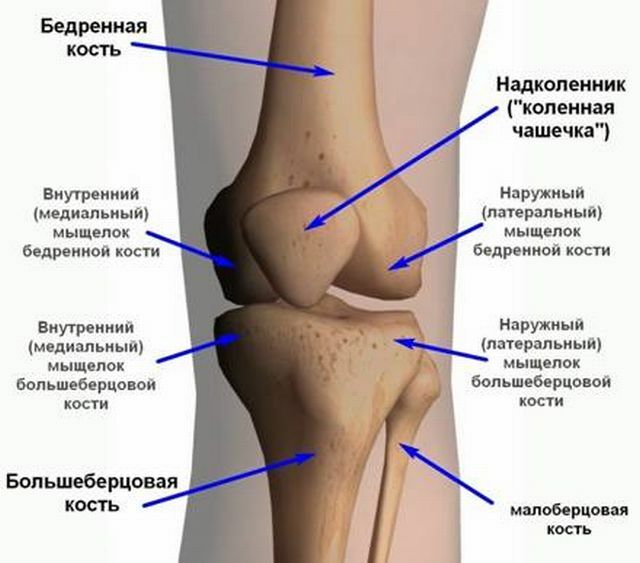
Contents of the article
- Features of the dislocation of the knee
- Do you run the risk of injury?
- Features
- symptoms of habitual dislocation and its features
- Subluxation Knee
- Congenital
- patellar luxation
- injury Diagnostics
- First Aid
- therapy in a medical institution
- LFK - also
- method recovery period
- Houses and walls help
- Possible complications
- Preventive measures
Features of knee dislocation
Knee dislocation - damage to the knee, due to various injuries that lead to displacement of the jointsthe surface of the bone, changing the location of one bone relative to the other, changing their anatomical position without compromising the integrity of their structures.
In case of dislocation, the capsule and ligamentous apparatus of the joint are damaged, the contact of the upper end of the tibia with the lower end of the femur is completely lost.
This pathology is manifested by swelling, impaired function and deformed limbs.
In medical practice, dislocation of the knee joint is diagnosed as:
- complete, in which the joint moves forward or backward due to severe mechanical stress, knee injury, or other trauma;
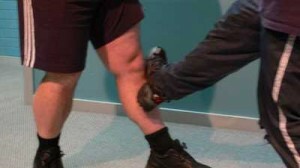
- incomplete - the displacement of the joint occurs outward or inward;
- closed;
- open;
- complicated, in which there is a rupture of muscle fibers and ligaments, fracture of bone structures;
- habitual dislocations.
Do you run the risk of injury?
The main reasons that led to this pathology include:
- strong, direct strokes in the patellar region;
- a sharp contraction of the quadriceps femoris when performing active movements;
- falls from height to knee joint.a similar kind of injuries is accompanied by a strong bruise of the legs, which were given maximum load during the jump;
- congenital pathologies and abnormalities.congenital weakness of the ligamentous apparatus, in which even the slightest effect can provoke trauma.
Knee dislocation can also occur in an accident, since a large force is pushed just in front of the person sitting in the car.
Athletes who engage in power sports, participate in sprint races, marathons, high jump, and bicycle racing are at risk.
Running and jumping can lead to stretching of the ligament structures and lead to dislocation of the knee.
Symptoms of
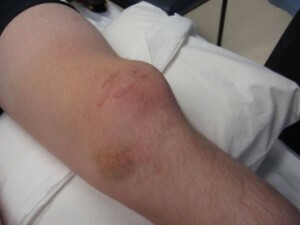 In the case of dislocation of the knee, depending on the location, strength and area of damage, and the causes that lead to knee injury, symptoms of varying intensity may appear.
In the case of dislocation of the knee, depending on the location, strength and area of damage, and the causes that lead to knee injury, symptoms of varying intensity may appear.
It is also important to understand that many of the signs of dislocations, sprains and fractures of the knees at the initial stage are similar.
The characteristic clinical features that are diagnosed in all forms of trauma are:
- sharp, severe pain in the joint area, which is particularly pronounced when moving;
- severe swelling, swelling;
- tissue hyperemia in the knee joint region;
- deformation, change of knee shape;
- numbness, feeling cold in the leg, loss of sensitivity below the injury site;
- no pulsation below the injured zone;
- decrease or total absence of joint mobility;
- increase in temperature.
Habitual dislocation and its peculiarities
A habitual dislocation of the knee arises in the kneecap as a result of repeated, periodic slipping of the kneecap from the usual channel of its slip.
The habitual dislocations can occur after the initial trauma of the patella.
Similar dislocation can occur even with minor injury, any other actions, for example, when lifting weights.
Accompanied by unpleasant, mild pain symptoms, discomfort, while the constant drop of the calyx can lead to the development of knee arthrosis.
To eliminate the pain symptom, you can patch the patella yourself.
The development of this pathology is promoted by:
- excessive elasticity of ligaments;
- too high patella arrangement;
- is not a fusion of the supporting ligament of the patella after injury;
- flattening of the sliding paths in the femur, as it is in this area that the groove that guides the patella is located.
Subluxation of the knee
Subluxation occurs in the patella and can occur with:
- rupture, a strong overstretch of ligaments that hold the cup;
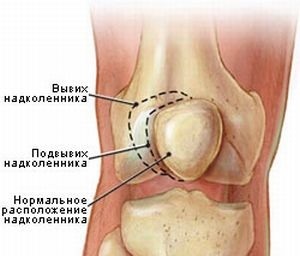
- weakening of muscular structures in the hip area;
- incorrect anatomical structure of the lower extremities.
Above listed reasons lead to unstable, unstable position of the patella, which, with the slightest injuries, bruises, physical exertion, sharp bending of the legs, easily undergoes this pathology.
The main symptoms of the patellar subluxation include:
- sensation of patellar instability;
- pain during movement, usually with knee flexion / extension;
- during movement, a characteristic crunch or click in the patellar region is heard, which occur when the normal sliding of the joint surfaces is disturbed.
This pathology with prolonged course can lead to the development of arthrosis and synovitis.
Congenital pathology
Congenital dislocation of the knee joint refers to rare, severe pathological diseases of the musculoskeletal system.
This pathology is not genetic and develops in the second trimester of pregnancy. In most cases, congenital knee dislocation is diagnosed in girls.
Treatment is based on the application of operational techniques.
Dislocation of patella
This pathology occurs quite often and can occur during running, performing sports exercises, dancing, with injuries, sharp bends.
Patella dislocation is classified into:
- habitual patellar dislocation;
- chronic dislocation;
- sharp.
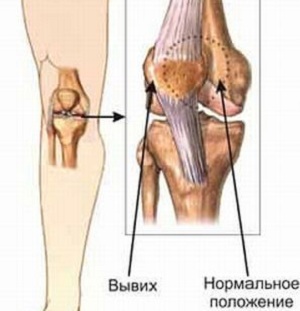 The main manifestation of this pathology is a sudden, severe sharp pain, a slight increase in the knee joint in the volume, a step-like deformation, swelling of the tissues.
The main manifestation of this pathology is a sudden, severe sharp pain, a slight increase in the knee joint in the volume, a step-like deformation, swelling of the tissues.
Pain sensations occur even with the slightest movement.
After an injury, the kneecap moves to the outside of the joint, causing severe pain.
After the time has elapsed, the cup can return to its normal position, but even then it is best to contact a specialist.
Diagnosis of trauma
It is possible to prescribe an effective treatment only after passing through complex diagnostics.
Diagnostic methods include:
- visual inspection;
- radiography;
- arteriography( roentgen arteries);
- pulse check, which allows you to determine the localization of damaged areas and whether there is a violation of blood circulation.
First Aid Assistance
If suspected dislocation of the knee, it is necessary to immobilize the injured limb as soon as possible with a tire or any improvised means.
If blood circulation in the foot or shin is disturbed, you can try to reduce the displacement of the bones by very gently pulling the foot along the longitudinal axis of the leg, slightly squeezing the shin in the direction opposite to its displacement.
Ice or a cold compress can be applied to the damaged area.
If suspected dislocation of the patella, you can give the victim an anti-inflammatory drug. The victim must be taken to the clinic for an appointment with a specialist.
Therapy in a medical institution
Any medical procedures should be performed and prescribed only by a medical specialist, as independent attempts at restoring the joint can worsen the condition and lead to fractures of the joint ends.
Conservative treatment with dislocation of the knee joint is performed only in a hospital. 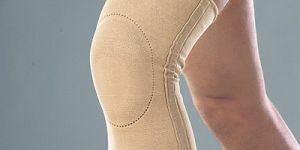
If necessary, the trauma doctor performs a puncture of the knee joint, removing the accumulated exudate.
All manipulations are performed under local or general anesthesia. After repositioning the knee joint and returning it to its place, fix the joint with an immobilizer or plaster bandage, which ensure the immobility of the injured limb.
The next stage of treatment includes a set of therapeutic and therapeutic procedures aimed at restoring the integrity of ligaments.
In severe cases, if an injury is associated with ligament and tendon ruptures in the patella area, surgery is performed. Minimally invasive surgery is performed using an arthroscope.
LFK - also the method
When treating a habitual dislocation, prescribe a course of therapeutic gymnastics( LFK), wearing a lateral knee tire. In severe cases, surgery is performed to stabilize the joint.
For the treatment of subluxation of the knee joint conservative methods of treatment are used.
Patients are assigned a set of specially designed exercises that contribute to strengthening of muscular structures, ligaments of the knee joint and allow to develop the correct technique of flexion-extensor movements.
During treatment, it is necessary to limit the mobility of the damaged limb, avoid overstrain, load on the leg, fix the limb while resting in a suspended state.
Patients are prescribed medication, taking symptomatic, analgesic, anti-inflammatory drugs.
Complete recovery and return of all functions occurs in the third to fourth month after the end of treatment.

Recovery period
After the end of treatment, the rehabilitation period must be under the control of the attending physician. To regain muscle tone, gradually begin to develop a damaged leg.
Fast recovery and recovery of functions is facilitated by:
- massage;
- physiotherapy techniques;
- physical therapy classes;
- correct, balanced nutrition;
- reception of vitamin-mineral complexes.
Houses and walls help
At home, non-traditional methods of treatment will help to speed up recovery processes after a knee joint dislocation.
Simple and effective folk remedies:
- Compresses, lotions based on medicinal herbs are applied to the place of dislocation.
- A good effect is provided by the application of a dairy compress. To do this, moistened in hot milk, a gauze dressing is applied to the damaged area for several minutes.
- It is also possible to apply a onion gruel with the addition of sugar, in a proportion of 1/10, to the site of the dislocation for five to six hours.
- You can make a mush from two or three heads of garlic with the addition of apple cider vinegar, which is insisted for a week in the fridge before use.
Possible complications of
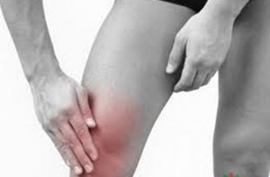 It should be noted that dislocation of the knee joint is a rather serious injury and its consequences can be very serious.
It should be noted that dislocation of the knee joint is a rather serious injury and its consequences can be very serious.
Incorrect treatment and inappropriate therapy can lead to complete restriction of knee mobility, to the appearance of permanent, aching, chronic pain.
Therefore, it is very important that when the first symptoms and signs of this pathology appear, immediately consult a doctor, in no case do self-medication and strictly follow all the recommendations and prescriptions of the medical worker.
Preventative measures
It is worth noting that people who adhere to the right, healthy lifestyle, exercise regularly, are less prone to dislocations of the knees.
Therefore, do not neglect physical activity, sports and aerobics.
To strengthen the ligamentous apparatus of the knee, improve the tone of the muscular structures of the lower limbs will help running, cycling, exercising in the gym, walking, swimming.
As a rule, with timely diagnosis and correct treatment, the prognosis is favorable. But it must be taken into account that if the medical prescriptions are not observed during the rehabilitation period, then pain can occur later.
It is very important to prevent re-injury of the patella or joint. After recovery, you should wear comfortable, practical and high-quality footwear that promotes the correct position of the foot while walking.
The first time is to minimize the load on the damaged limb, avoid sudden movements, hypothermia.
If the dislocation of the knee has taken a chronic form, which is accompanied by frequent, aching pains, surgery will most likely be required.

